Nombre:
Puerto de Génova
Otro:
Localización:
View Larger Map
Tipo: Puertos
Categoría:
Foto:
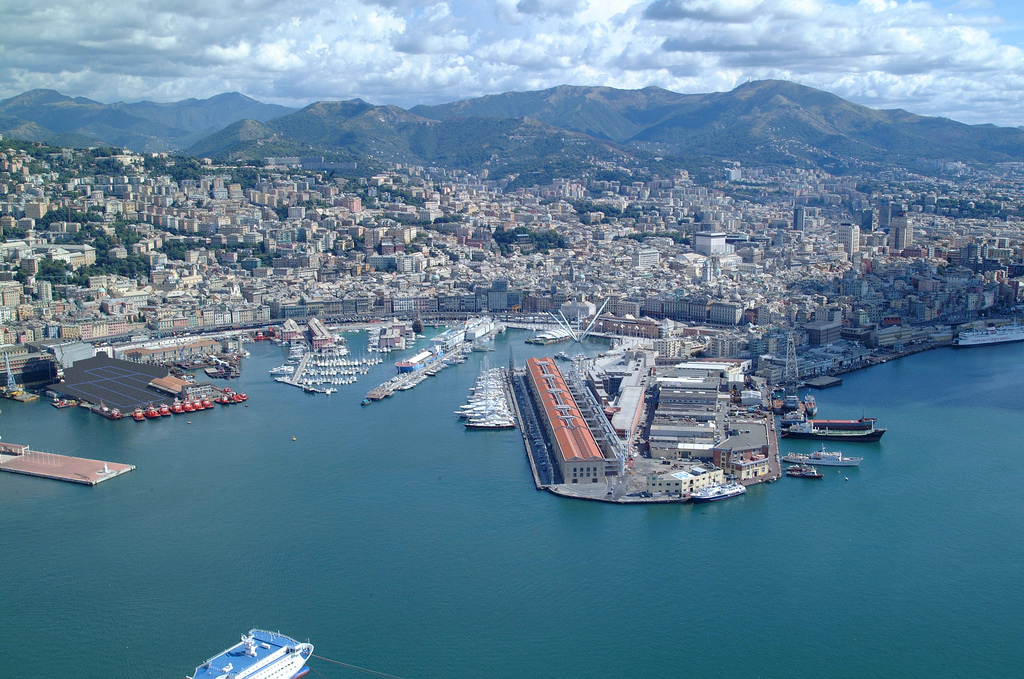
Voto:
Continente: Europa
País: Italia
Localización:
Año: -600
Estado: Terminado
Descripción:Génova, para navegantes.
Génova (antigua Genua) es una ciudad del noreste de Italia, en la región de Liguria, con un puerto marítimo localizado en el golfo de Génova. La ciudad se sitúa próxima a una bahía, al pie de un paso de montaña de los Apeninos occidentales.
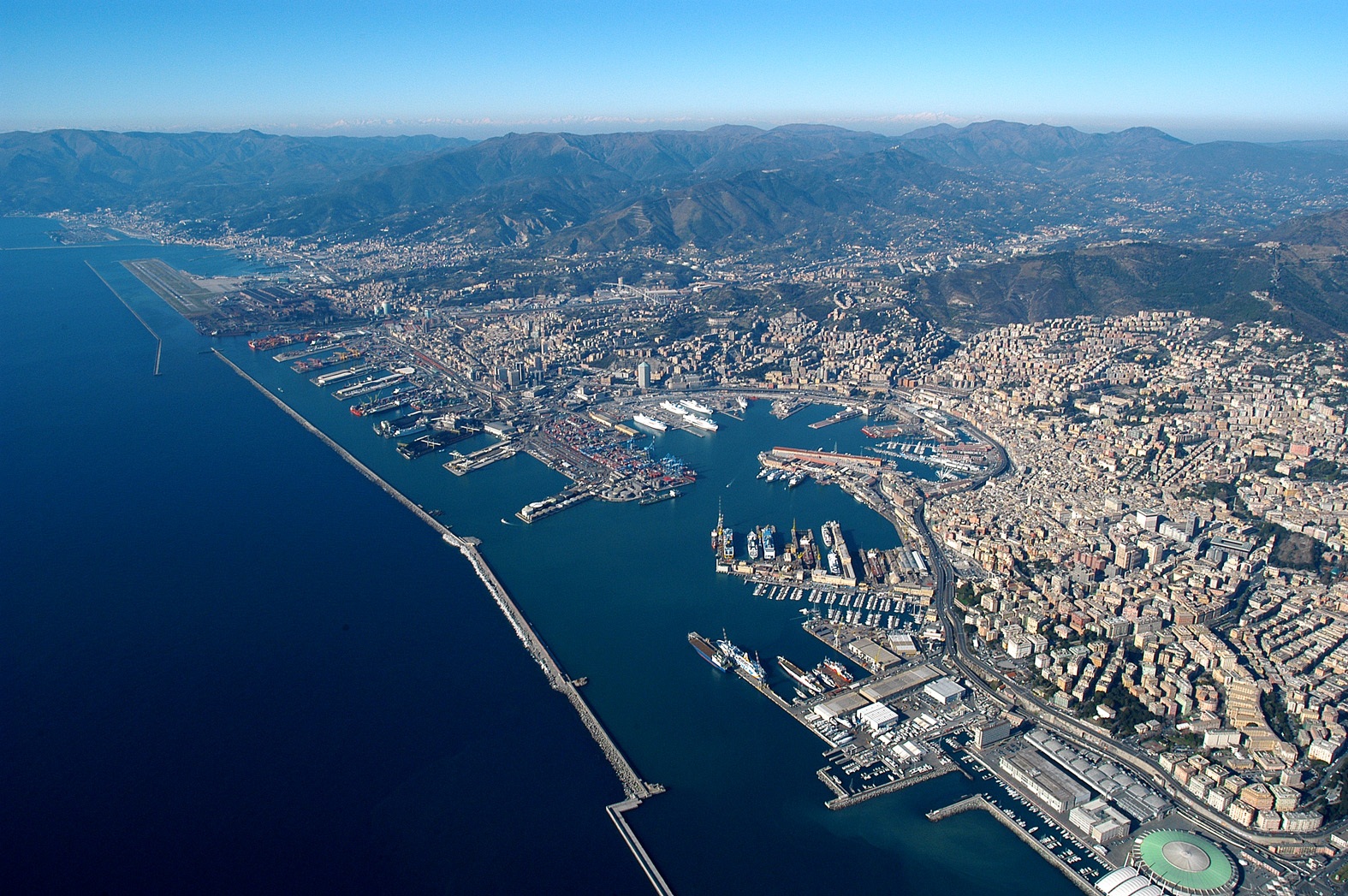

Rivaliza con Marsella (en Francia) como primer puerto europeo del mar Mediterráneo y es el centro comercial de los sectores industriales de Piamonte y Lombardía, así como de las ricas regiones agrícolas del norte de Italia y del centro de Europa. La principal industria de Génova es la construcción de navíos. Otras industrias importantes son las fábricas de productos de hierro y acero, motores y componentes de vehículos, equipamiento de refrigeración, municiones, productos químicos, jabón y tratamiento de productos agrícolas.
La zona antigua de la ciudad ocupa una franja estrecha de la llanura costera, al este y al norte del puerto viejo, que eha sido ampliado con la adición de un puerto exterior protegido por rompeolas. En el corazón de la zona antigua se encuentra la iglesia románico-gótica de San Donato, y enfrente del puerto se levanta el palazzo San Giorgio.
La catedral de San Lorenzo contiene un rico conjunto artístico. El gran palazzo Ducale es en la actualidad sede de la cámara legislativa. En la piazza San Matteo están las casas de la familia de los Doria y la iglesia de San Matteo, que contiene la tumba de Andrea Doria, almirante y hombre de estado genovés. En el noroeste, cerca de la Stazione Marittima se encuentra la iglesia de la Annunziata, del siglo XIII, notable porque encierra en su interior magníficas obras de arte. El supuesto lugar de nacimiento de Cristóbal Colón está también entre los monumentos históricos de Génova.
http://www.fotonostra.com/albums/europa/genova.htm
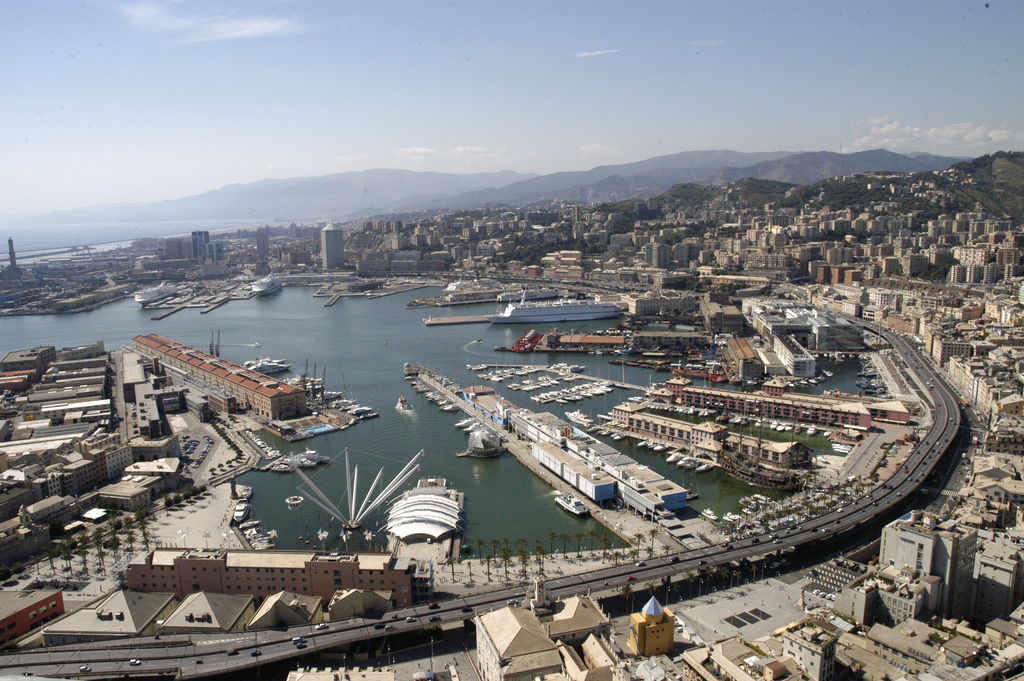
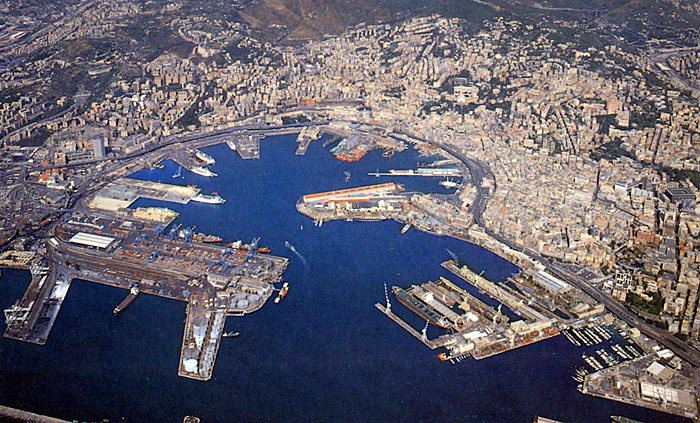
Il Porto di Genova
Il Porto di Genova, favorito dalla posizione geografica strategica, è posto al centro dell'importante area industriale e commerciale del nord Italia e del sud Europa. Mette al servizio degli utenti e della merce le doti di esperienza e professionalità, frutto di una secolare tradizione marittima e portuale.
Nel 1994 il governo italiano ha approvato la legge di riforma portuale 84/94 - oggi oggetto di prossima riforma - che ha introdotto la gestione privata delle operazioni all'interno del porto, pur mantenendo alle Autorità Portuali i delicati e fondamentali compiti di gestione delle concessioni delle aree, la pianificazione delle opere in ambito portuale, il controllo degli standard di sicurezza sul lavoro e sul naviglio, nonché la promozione dei servizi e dell'organizzazione.
Il Porto di Genova si estende ininterrottamente per 22 chilometri lungo una fascia costiera che si sviluppa dalla Fiera fino a Voltri. E’ uno scalo polivalente e multifunzione che dispone di oltre venti terminal operativi privati, attrezzati per accogliere ogni tipo di nave per ogni tipo di merce: contenitori, merci varie, prodotti deperibili, metalli, forestali, rinfuse solide e liquide, prodotti petroliferi e passeggeri.
Dispone di alcune società che offrono una serie di servizi complementari, dalle riparazioni navali all'ambiente. La superficie occupata dall’insieme delle infrastrutture portuali è pari a circa sette milioni di metri quadrati, a cui è possibile accedere attraverso diversi varchi posti in corrispondenza delle principali direttrici del traffico.
Negli ultimi anni i traffici hanno fatto registrare una tendenza positiva: oggi infatti Genova è il primo porto italiano in termini di movimentazione complessiva ed è fra i primi porti mediterranei di destinazione finale per quanto riguarda il trasporto containerizzato.
Il rapido aumento del traffico è senza dubbio collegato al fatto di essere diventato il punto di riferimento per le maggiori società di gestione dei servizi portuali su scala mondiale. Oltre 150 servizi di linea collegano Genova ai maggiori porti in tutto il mondo. La vicinanza ai più importanti centri di produzione industriale e di consumo in Italia (Milano e Torino distano solo 150 km) e la prossimità alle principali aree industriali del centro Europa, come Basilea (Svizzera), Monaco di Baviera (Germania) e Vienna (Austria), fanno del porto di Genova un’ideale porta di accesso da sud per i traffici marittimi da e per l’Europa, oltre che il naturale punto di riferimento per il commercio con il Far East.
La globalizzazione del comparto logistico ha comportato l’adozione di una serie di scelte coerenti con le trasformazioni in atto nel settore marittimo-portuale e, più in generale, nel mercato del trasporto, che rappresentano una sorta di linee-guida per un ulteriore sviluppo economico e territoriale, sintetizzabili nell’ampliamento delle strutture dedicate alla ricezione dei contenitori e dei carichi convenzionali, nello sviluppo delle reti intermodali per allargare gradualmente il bacino di utenza verso le aree industriali europee, nella realizzazione di centri intermodali appropriati. A questo proposito l’Autorità Portuale di Genova ha intrapreso un percorso volto alla creazione di un “porto esteso”, orientando la scelta verso la zona di Alessandria per la sua posizione centrale rispetto all’asse ferroviario ed autostradale di collegamento tra Genova ed i mercati del Nord Italia e Sud Europa (Svizzera, Baviera).
Negli ultimi anni sono stati sviluppati i collegamenti ferroviari quotidiani con l’Interporto di Rivalta Scrivia ubicato in posizione equidistante dalle direttrici Milano-Torino.
http://www.porto.genova.it/index.php/it/il-porto-di-genova
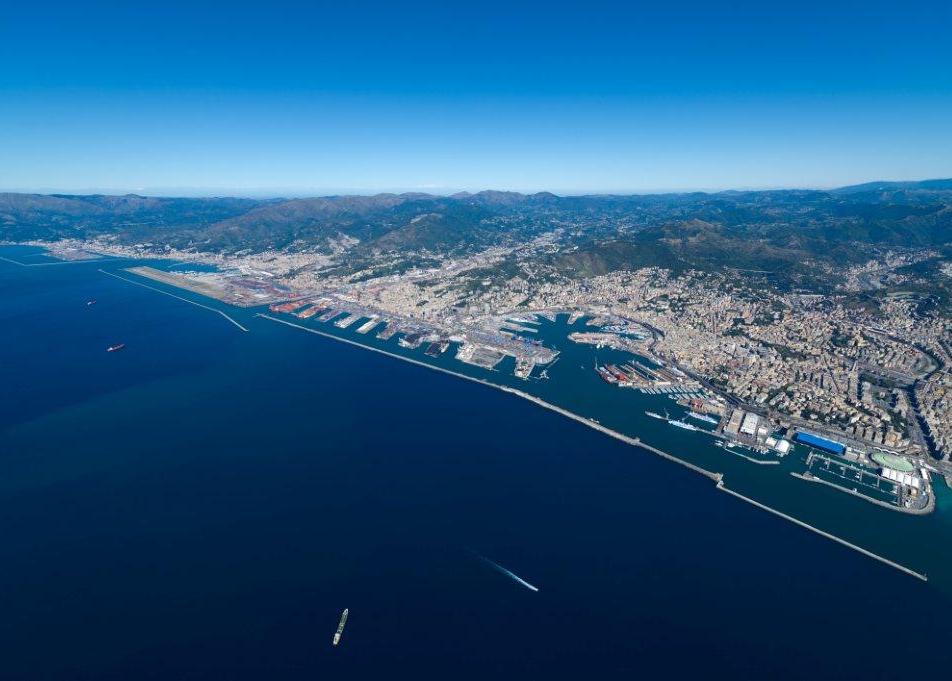
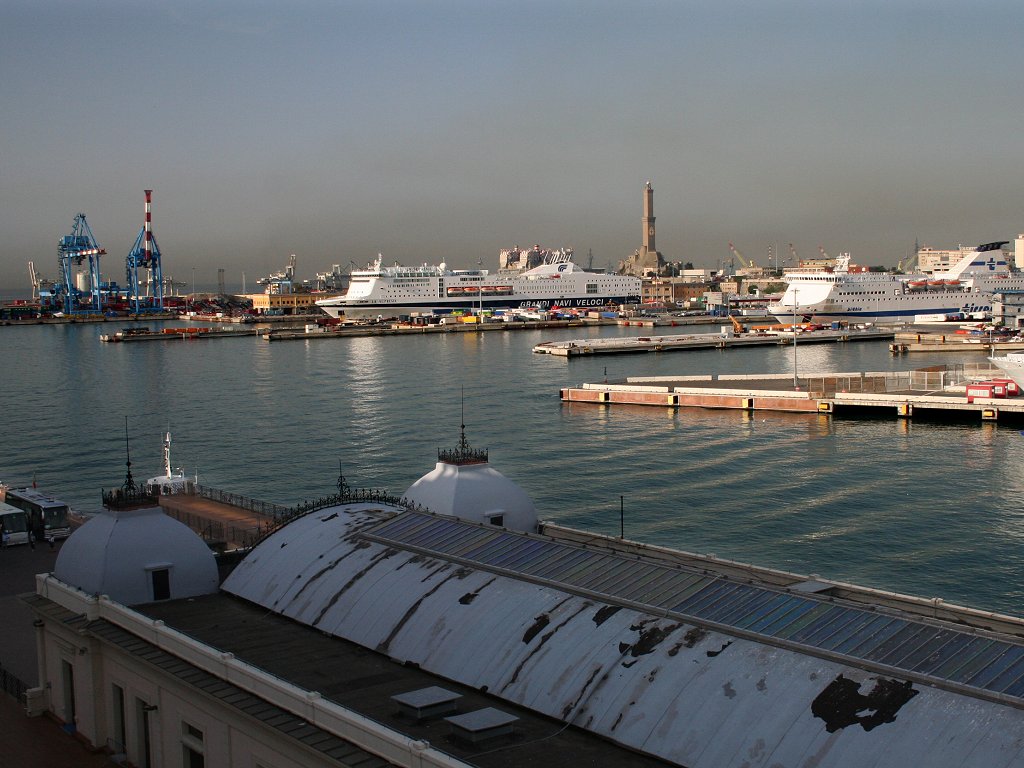
Il porto di Genova è - in termini di traffici e di ampiezza - il maggiore porto industriale e commerciale italiano e, in concorrenza con Marsiglia e Barcellona nel Mediterraneo, uno fra i più attivi di tutta Europa.[1]
Posizione strategica
Sbocco naturale al mare delle regioni del Nord-Ovest italiano, e situato in posizione strategica verso hinterland economico e commerciale europeo, il porto di Genova ha una storia ed una tradizione antichissime.
Si sviluppa, partendo da levante verso ponente, dal bacino delle Grazie (l'area ove sorgono i cantieri e le officine delle riparazioni navali), poco distante dal quartiere fieristico della Foce e dal porticciolo turistico Duca degli Abruzzi, fino ai moderni terminal per la movimentazione delle merci varie poco discosti dalla Lanterna.
Lo scalo - che ha il suo naturale completamento nel porto petroli di Multedo, vicino a Pegli, e nel terminal container di Voltri - comprende al suo interno, lungo i circa sei chilometri di strada sopraelevata che definiscono anche visivamente il cosiddetto waterfront, includono l'area del rinnovato porto antico. Nel tratto di costa fra Cornigliano e Sestri Ponente alcuni moli sono riservati ai cantieri di costruzioni di nuove imbarcazioni della Fincantieri.
In sostanza il porto di Genova restituisce alla città un valore simbolico aggiunto che va oltre il significato strettamente funzionale: il porto è infatti la città stessa e ne costituisce buona parte della sua storia.
Ma una tale storia è composta anche di dure vertenze sindacali, registratesi specialmente in anni più recenti, come quella che contrapposte a fine anni ottanta i responsabili dei lavoratori portuali - i camalli eredi dei vecchi caravana addetti al carico/scarico dei piroscafi a tre alberi ormeggiati alle vecchie banchine e ai silos granari - e l'autorità portuale messa di fronte alla necessità di un radicale rinnovamento indispensabile per fronteggiare la concorrenza che si faceva sempre maggiormente pressante dei porti del nord Europa.
Il porto di Genova in cifre
Situato geograficamente nella parte più settentrionale del mar Ligure, lo scalo genovese occupa circa cinquecento ettari di superficie a terra e altrettanti sullo specchio acqueo.
Le opere marittime su cui si basa si estendono per quarantasette chilometri di lunghezza cui trenta chilometri per i soli pontili operativi; la profondità dei fondali varia dai nove ai quindici metri con punte di cinquanta.
I tredici terminal in cui si articola l'attività di movimentazione di merci e passeggeri hanno una copertura di collegamenti garantiti dalle principali compagnie di navigazione da e per ogni località del mondo, con volumi di traffico di assoluto prestigio.
Due sono i fari principali: oltre a quello conosciuto universalmente come la Torre della Lanterna di Genova, che sorge sulla collina di San Benigno, nella zona di Sampierdarena, vi è quello, minore e dedicato alle superpetroliere, ubicato a Punta Vagno, nella zona residenziale di corso Italia.

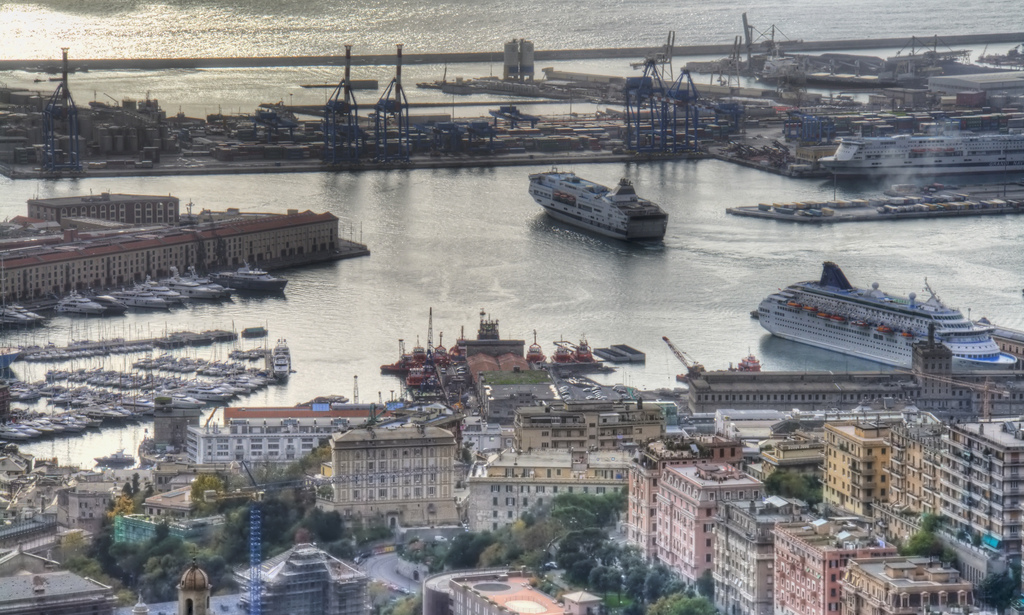
Analisi dei traffici
Generalità
La movimentazione delle merci nel porto di Genova è quanto mai variegata e ugualmente articolato è il traffico dei passeggeri che usufruiscono della Stazione marittima del terminal crociere e del moderno terminal traghetti con linee per le maggiori località del mar Mediterraneo. In passato questa zona del porto serviva anche come base per l'imbarco sui transatlantici della Società Italia e di altre compagnie di navigazione di linea.
Dopo aver conosciuto un lungo periodo di crisi - susseguente al ristagno economico degli anni settanta e anni ottanta, ma dovuto anche ad un inasprimento della conflittualità per le condizioni di lavoro e remunerazione delle maestranze portuali - i famosi camalli - lo scalo ha ripreso nuovo vigore negli anni novanta riportando la propria quota di mercato su valori di eccellenza.
Nel periodo precedente la seconda guerra mondiale (ovvero nelle prime quattro decadi del Novecento) il volume di merci movimentate a Genova era cresciuto da circa cinque a otto milioni di tonnellate di merci movimentate.
È negli stessi anni che lo scalo portuale ligure ha iniziato una crescita soprattutto in direzione del ponente, ovvero oltre il bacino della Lanterna, con la realizzazione del nuovo porto di Sampierdarena e l'edificazione - di fatto strappando territorio al mare, del moderno terminal container di Voltri, operativo dagli anni novanta.
Fortemente danneggiato dai bombardamenti del 1942 e del 1943 per la seconda guerra mondiale, il porto riuscì nell'immediato dopoguerra a riconquistare una quota di otto milioni di tonnellate di merci manipolate, eguagliando il dato storico ante-guerra.
A metà degli anni settanta il traffico merci era aumentato di oltre sette volte, superando i sessantadue milioni di tonnellate.
Durante gli anni ottanta si è avuta una nuova contrazione che ha riportato il tasso di attività a valori modesti (circa quaranta milioni di tonnellate di merci movimentate), ma con la ripresa di fine anni novanta il volume delle merci trattate è tornato a superare 50 milioni di tonnellate l'anno.
Uguale tendenza ha seguito il movimento di passeggeri - traghetti e crociere - che, nel 2003 ha superato la quota annua record di 3,35 milioni di passeggeri transitati dallo scalo genovese.
***
Sezioni del porto
Da ovest ad est il porto si suddividere nelle seguenti principali sezioni:
V.T.E. - Voltri Terminal Europa: è il maggiore terminal container del porto con una capacità attuale di 1,5 milioni di TEUs all'anno. Fu inaugurato nel luglio del 1992.[3]
Bacino di Multedo - Sestri Ponente:
Porto Petroli: importante porto petrolifero a livello europeo situato davanti al quartiere di Multedo.
Porticciolo turistico di Sestri Ponente: A seguito della riqualifica del bacino interno ricavato dalla penisola aeroportuale con la costruzione della Marina di Genova Aeroporto, i posti barca la capacità del porticciolo è stata portata fino a circa 2000 con la disponibilità di ormeggio anche per grandi yatch fino a 90 metri.
Aeroporto di Genova-Sestri Ponente
Bacino di Sampierdarena: importantissima zona del porto nel quale sono concentrate numerosi terminal dediti al commercio navale di merci varie (come il Terminal Frutta e il Genoa Metal Terminal) e di container (Terminal Messina).
S.E.C.H. - Southern European Container Hub:[4] è un altro importante terminal container gestito da Terminal Contenitori Porto di Genova situato tra il Porto Antico e il Bacino di Sampierdarena.
Stazioni Marittime: area del porto gestita da Stazioni Marittime S.p.a che controlla il trasporto dei passeggeri tramite vari terminale per concessione statale fino al 2040.
Porto Antico: è l'area dove sorsero le prime attività portuali di Genova. In occasione delle celebrazioni del cinquecentenario della scoperta dell'America l'intera area del Porto Antico è stata totalmente riqualificata su progetto dell'architetto Renzo Piano nel 1992.
Area di Levante: zona perlopiù dedita alle riparazioni navali. A levante di quest'area, presso il quartiere della Zona si trova l'area della Fiera all'interno della quale ogni anno nel mese di ottobre si svolge il Salone Nautico di Genova, mostra espositiva di imbarcazioni con rilevanza internazionale.
http://it.wikipedia.org/wiki/Porto_di_Genova
http://en.wikipedia.org/wiki/Port_of_Genoa
Port of Genoa
Located on the shores of the Liguarian Sea, the Port of Genoa is the hub of Italy's Riviera and the capital of the Genova province and the Liguria region. The Port of Genoa is just over 50 nautical miles northwest of the Port of La Spezia in Italy and 100 nautical miles northeast of the Port of Cannes in France. The city covers the western slope of the Apennine Mountains and a narrow coastal plain along the sea. In 2004, over 600 thousand people called the Port of Genoa home.
With a long maritime history, the Port of Genoa enjoys a wonderful climate. Tourism is its most important economic sector, but it was an important industrial center in the past. Today, the old factories have converted into other businesses that include banking, insurance, communications, commerce, and services. Having been one of the four Sea Republics in ancient Italy, the Port of Genoa was tremendously powerful and wealthy. It seaport has long been the foundation for the city's economy. In 2004, Genoa was selected as one of two European Capitals of Culture by the European Union.
Port History
The Port of Genoa was occupied by the Ligures, an ancient Italic tribe, as early as the 6th Century BC. Calling themselves Ambrones, meaning "people of the waters," their culture stretched from northern Italy into Gaul. They were eventually absorbed by the Gauls and later by the Romans.
A 6th Century BC cemetery in the Port of Genoa proves that Greeks occupied the site, but historians believe the harbor was in use long before that. Scholars suggest that the Etruscans and the Phoenicians probably had sea bases in the Port of Genoa.
The Port of Genoa's development and growth was intimately connected to maritime trade and traffic in these ancient days. Cultures with languages other than Ligurian established settlements on Castle Hill from the 6th Century to operate manage their sea-borne trade. During this era, the Port of Genoa was little more than a small sheltered Bay.
During the era of the Roman Empire, the Port of Genoa was in the shadow of Marseille. Being allied with Rome during the Second Punic War, the Carthaginians destroyed the city in 209 BC. The Port of Genoa was rebuilt, and it won municipal status after the end of the Carthaginian Wars. It was a castrum, or fortified Roman town, with busy trade in skins, wood, and honey that were transported to mainland cities.
After the Western Roman Empire fell, the Ostrogoths occupied the Port of Genoa. Then the Byzantines made it the base for their local governor after the Gothic War. During the 7th Century AD, the Germanic Lombards ruled the Port of Genoa, and they destroyed the city's Roman walls.
When the Frank Empire conquered the Lombards, the Port of Genoa became part of that kingdom in 773 under the rule of Ademarus, the first Carolingian count of Genoa. The city's walls were rebuilt during this period.
For many centuries, the Port of Genoa was a simple, small fishing village with a slowly-growing merchant fleet. Arab pirates sacked and burned the town in 934, but it was soon rebuilt. Trade began to grow again, and wealthy merchants built the first wooden wharves to import goods like silk and spices from the Islamic world.
During the 10th Century, the Port of Genoa became one of several independent city-states in Italy, a "Maritime Republic" like Venice, Pisa, and Amalfi. While the Holy Roman Empire was the ruling body, and the Bishop of Genoa was president of the city, the Port of Genoa was really ruled by an elected popular assembly. The ports trade, ship-building, and banking activities gave it one of the biggest and most powerful navies in the Mediterranean region. Merchant families in the Port of Genoa struggled for domination.
The Republic of Genoa controlled an area that included all of Liguria, Piedmont, Corsica, and Sardinia. It also had near-complete control over the Tyrrhenian Sea to the east of southern Italy. Through its participation in the Crusades, the Port of Genoa established colonies in the Middle East, Northern Africa, Sicily, and the Aegean Sea region. Crusaders from Genoa brought back a glass goblet from Arabia that the people honored as the Holy Grail.
Allied with the Byzantine Empire, the Port of Genoa was relatively unscathed by the collapse of the Crusader States. It was able to expand into the Crimean and Black Sea areas. The Republic of Genoa ran like a business for many years. The Port of Genoa reached its political peak in the late 13th Century when it won the naval Battle of Meloria in 1284 over the Duchy of Pisa and when it defeated Venice in 1298.
The Black Death brought an end to the Republic's golden age when the disease arrived in Europe from the Genoese trading post at Theodosia in the Crimea. The Port of Genoa suffered a near-total population and economic collapse.
After the plague subsided, the Port of Genoa adopted Venice's style of government under a ruling doge (or duke). The Port of Genoa continued to struggle with its long-time rival, Venice. In 1381, the War of Chioggia ended when Venice defeated Genoa. For a time in the late 14th Century and early 15th Century, the French dominated the Port of Genoa. After that, the Visconti of Milan ruled the city. Genoa lost Corsica when it revolted. It lost its colonies in the Middle East to the Ottoman Empire and Arab powers, and it lost Sardinia to the Kingdom of Aragon.
Christopher Columbus was born in the Port of Genoa, and he donated a tenth of his income from discovering the Americas to Genoa's Bank of San Giorgio to relieve the city from taxes on food. In 1528, Andrea Doria instituted a new constitution for the Port of Genoa that brought it under the control of the Spanish Empire.
The city underwent an era of economic recovery, bringing new fortunes to many Port of Genoa families. The Port of Genoa reached a new peak in the 16th Century, and it was a magnet for many world-famous artists and architects.
In 1684, the French bombarded the Port of Genoa, and Austria occupied the city in 1746. In 1768, the city had to turn Corsica over to the French. With the introduction of trade routes to the New World and away from the Mediterranean region, the Port of Genoa's fortunes began to decline. At the end of the 18th Century, Napoleon made the Port of Genoa a French protectorate, calling it the Ligurian Republic. France then annexed the new republic in 1805.
In 1814 when the Genoese revolted against France and won independence for the Port of Genoa, the city was incorporated into the Kingdom of Sardinia, ruled by the House of Savoy, with the approval of the Congress of Vienna. While its union with Savoy brought economic stability to the Port of Genoa, the citizens chaffed at the control and revolted.
In 1860, world-famous freedom fighter Giuseppe Garibaldi departed the Port of Genoa with more than a thousand volunteers to begin the Second Italian War of Independence. The "Expedition of the Thousand" brought an end to the Kingdom of the Two Sicilies and was a first step in the eventual creation of the unified Kingdom of Italy.
Italy's unification in 1861 increased the Port of Genoa's influence, and it was Italy's most important commercial port, competing with Marseille for Mediterranean trade. It also completed with ports in the North Sea for trade with Switzerland and inland central Europe.
When international trade began to decline in the 20th Century, the Port of Genoa enjoyed increasing trade to and from northern Italy.
Port Commerce
Italy's port reform law of 1994 authorized the establishment of port authorities to replace earlier port management organizations, and the management of port areas and terminals was transferred to private operators. The Port Authority of Genoa (Italian) was established. Some tasks remained the responsibility of the port authorities including planning, coordinating, and controlling port operations; assuring safety; maintaining the Port of Genoa's common areas; and overseeing general-interest services provided to port users.
Since 1903, the Port Authority of Genoa has been headquartered in Genoa's first public building. Built in 1260, the Palazzo San Giorgio was built by the uncle of the first Doge of Genoa. The materials used for the building came from the Venetian embassy in Constantinople as a reward for the Genoese help against the Latin Empire. Marco Polo was the most famous resident of the Palazzo San Giorgio. The building was used as a prison for a time, and it was home to the Bank of San Giorgio from the 15th Century.
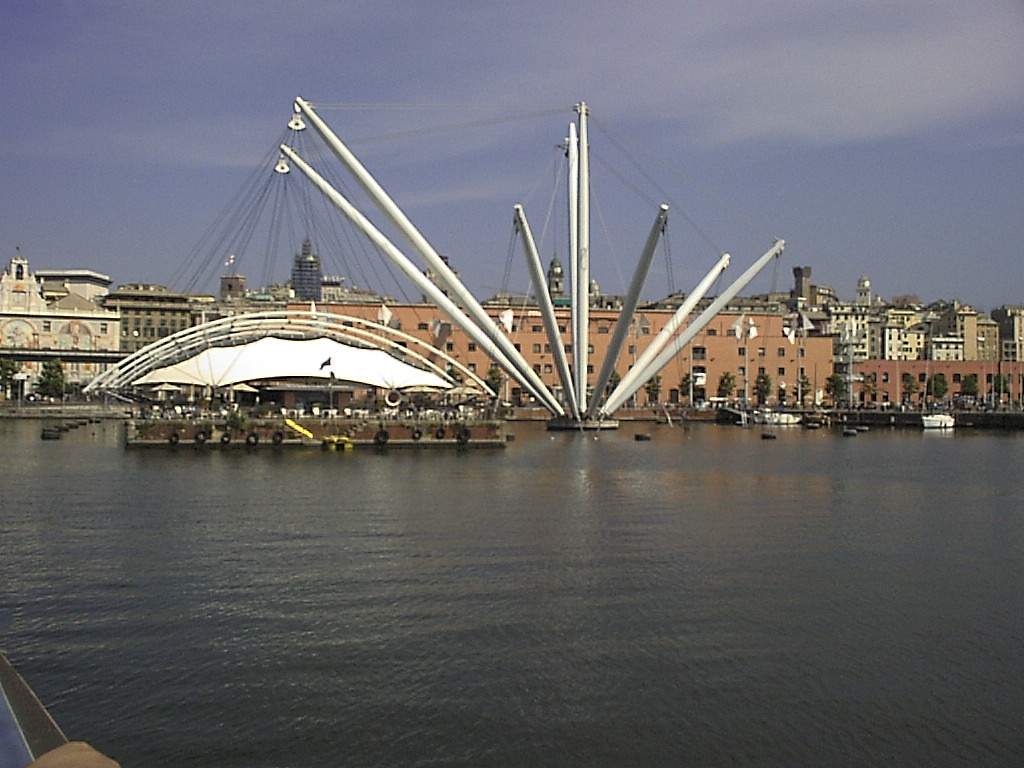

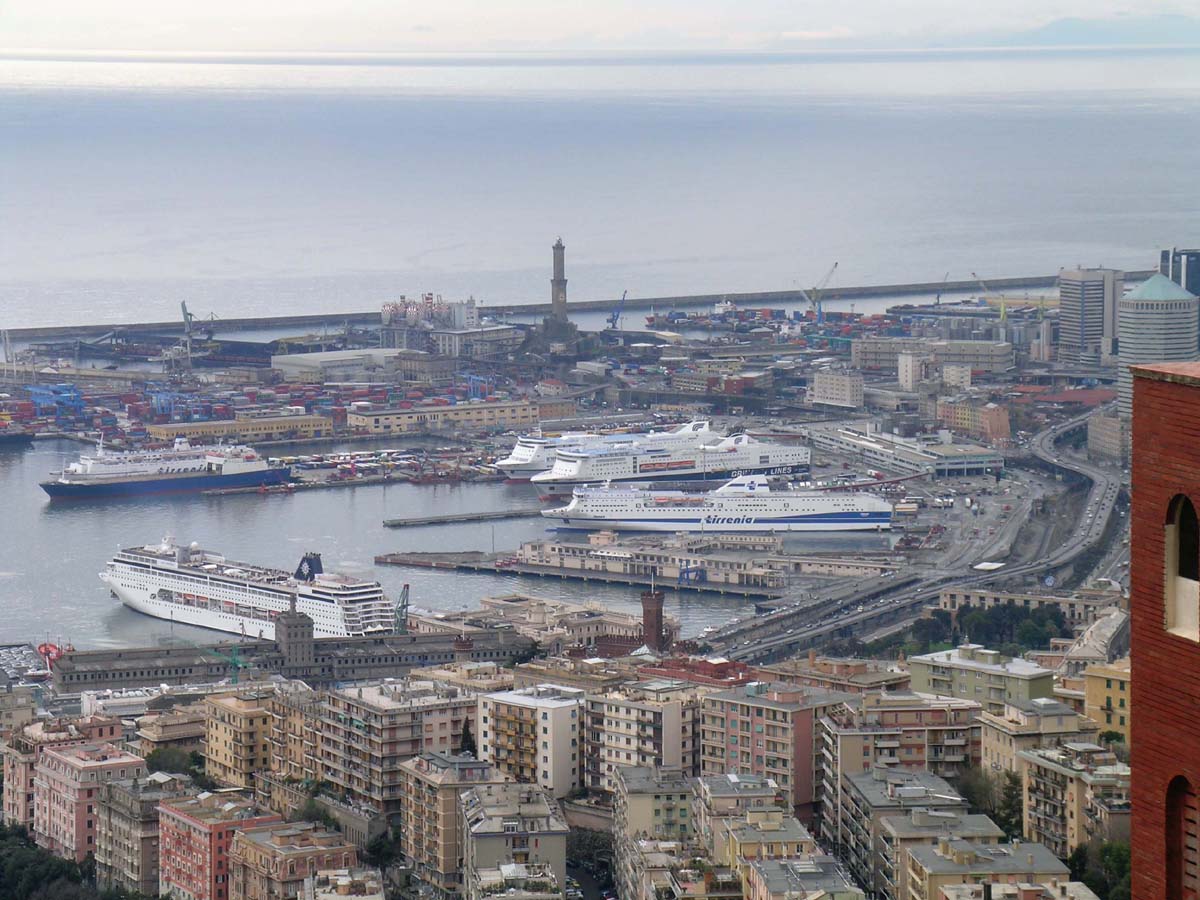
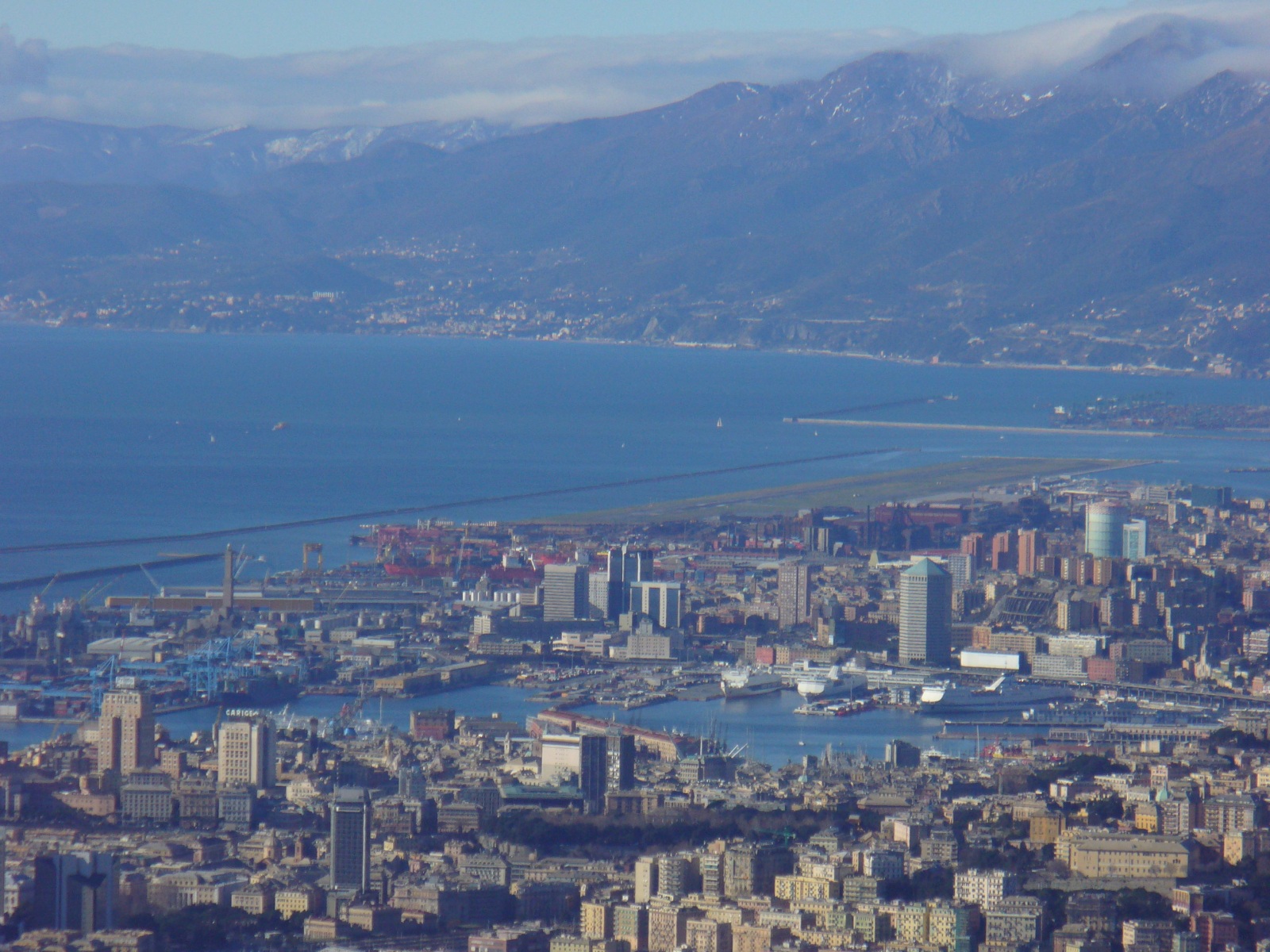
The Port of Genoa serves Italy's most industrialized area in the north, and it is ideally located to serve central Europe's consumer markets. Over seven thousand ships call at the Port of Genoa each year, and the port offers a wide range of specialized services to support any type of ship or cargo.
From its birth, the Port of Genoa has been Italy's gateway to the Mediterranean and to international cultures that make it one of the modern world's most interesting tourist destinations.
The Port of Genoa's new Passenger Terminals are located in the beautiful historic heart of the city where modern and ancient structures and traditions mix. The city's rich maritime history has left its mark on the Port of Genoa over centuries of seafaring, mercantile development, and trade-related activities.
The Port of Genoa's restyled waterfront contains the Maritime Station containing the ferry terminal and cruise terminal. Maritime Station operations include both commercial trade4 and passenger services. The Station contains five passenger terminals, three used for ferry traffic and two for cruises.
In 2007, the Port of Genoa handled a total of 58.6 million tons of cargo carried on more than 7800 vessels. Over 3.2 million passengers visited the Port of Genoa in 2007, including 2.7 million ferry passengers and over 520 thousand cruise passengers.
Cargoes handled by the Port of Genoa in 2007 included 29.7 million tons of general cargo (18.8 million tons of that in 1.8 million TEUs of containerized cargo), 21.5 million tons of liquid bulk (including 20.5 million tons of mineral oils), almost 6 million tons of solid bulk, and 1.5 million tons of bunkers and supplies.
Cargoes in 2007 included almost 40 million tons of imports and 18.7 million tons of exports. The single largest cargo category was general cargo (27.5 million tons), and crude oil made a significant portion (15 million tons) of cargo handled by the Port of Genoa in 2007. Other major cargo categories included hydrocarbons (3.9 million tons), energy derivatives (1.9 million tons), vehicles (1.2 million tons), and coal (881.6 thousand tons). Other cargoes over 100 thousand tons handled by the Port of Genoa included chemical products, vegetable oils and animal fat, ferrous minerals, coke, non-ferrous metals, cement and lime, scrap and blast furnace powder, fresh and frozen vegetables and fruit, cellulose and waste, cereals, and pig iron.
Cruising and Travel
The City of Genoa (Italian) boasts the charm of an old seaport and centuries of history. Its Old Town is filled with narrow alleys, ancient churches, and Renaissance palaces. The Piazza de Ferrari is a large public square at the center of many of the city's most popular sights. Travelers can visit the breathtaking Cathedral of San Lorenzo, the home of Christopher Columbus (Casa della Famiglia Colombo), the Biosfera greenhouse, and the beautiful and historic Palazzo Ducale (Palace of the Doges). There are far too many things to see and do in the Port of Genoa than can be described in this article. For more information, visit the city's tourism website.
The Port of Genoahas a wonderful Mediterranean climatewith comfortable temperatures ranging from an average high of 27 °C (81 °F) in August to an average low of 5 °C (41 °F) in January. July is the driest month of the y ear, and October and November are the rainiest. The Port of Genoa gets about one snowfall each year. The Port of Genoa is windy, especially during the winter, but those winds bring cool temperatures during the hot season.
The Acquario di Genova is Europe's biggest aquarium, offering the continent's largest exhibition of aquatic biodiversity. The exhibits include sea and water habitats, tanks with a wide variety of aquatic species, and a petting pool for children. With 71 tanks containing more than four million liters of water and 600 species of plants and animals, some of the most popular attractions include the penguins, seals, and sharks. At one end of the Aquarium of Genoa is a ship where the walls are virtual tanks in which visitors can hear the waves and watch the currents of the sea.
The Palazzo Reale (or Royal Palace) is the Port of Genoa's best example of a princely home. The 17th Century building was enlarged by the Durazzo family in the 19th Century. Its 18th Century hanging gardens line the passage to the stairway leading to the "aristocratic" floor where visitors find luxurious rooms decorated with fine frescoes and paintings and furnished with some of the original furniture. The Mirror room to the Throne room contains a Van Dyck portrait of Caterina Durazzo. The bedchambers for the King and Queen, the Tapestry room, and the glorious Ballroom contain awesome treasures. From the terrace, visitors take in wonderful views of the old city and the port.
Home to the Port Authority of Genoa, the Palazzo San Giorgio (Italian) was built in 1260 by Guglielmo Boccanegra. The building has a rich history, having been at one time the home of world explorer Marco Polo and, for a while, a prison. The palace was built to create a political center that would rival the clerical power of the Cathedral of San Lorenzo. In the 15th Century, it became home to the Bank of Saint George.
The 1543 Lanterna is a well-loved landmark for the residents of the Port of Genoa. Legend says that the architect was forced to leap from the top of it so that he could never build another lighthouse like it. The 77-meter-tall Lanterna tower is the Port of Genoa's symbol. Built on a 40-meter-tall rock, the top of the tower is 117 meters above sea level, and it is visible for over 50 kilometers. Restored in at the turn of this century, the Lanterna includes a promenade and a museum. The 800-meter promenade begins at the Ferry Terminal and guides visitors to the fortifications, the museum, and the Lanterna. The Museum, housed in the Savoy fortifications, contains displays of lamps, lenses, and many lighthouse-related objects as well as films telling the story of the Port of Genoa's development.
http://www.worldportsource.com/ports/ITA_Port_of_Genoa_52.php
http://www.skyscrapercity.com/showthread.php?t=1489431
http://shippingonline.ilsecoloxix.it/p/container/2012/01/21/AP78vGjB-genova_storico_record.shtml
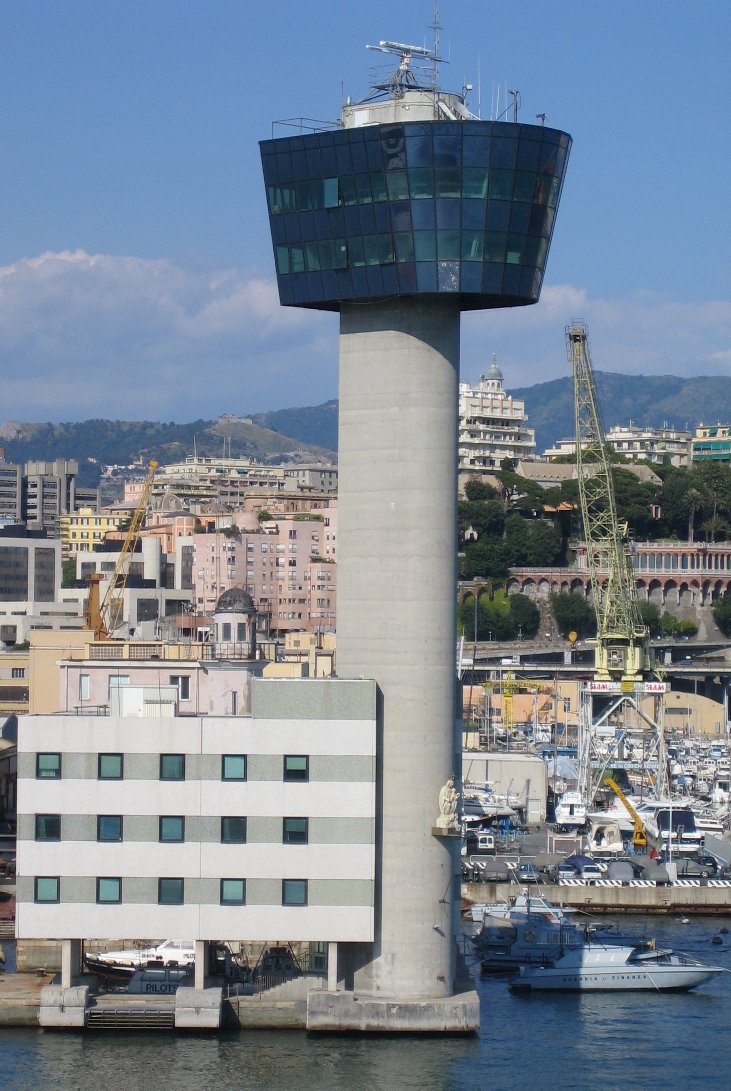
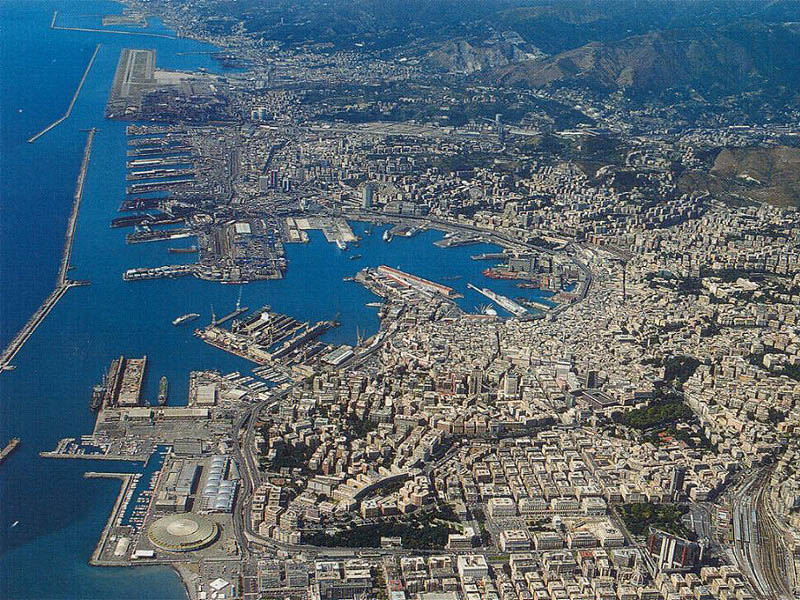
El puerto de Génova
Publicado por Yolanda Fernandez
Génova tiene el primer puerto de Italia y el segundo en importancia del Mar Mediterráneo después de Marsella. Esta ciudad nació como una aldea y prosperó gracias a los contactos con etruscos y griegos hasta convertirse en una de las cuatro repúblicas marítimas de la Península Itálica. Su símbolo es la Lanterna, el faro en activo más antiguo y con una leyenda que dice que si se apaga de repente, llegarían 5 años y 5 meses de desgracia a la ciudad.
Cuando llegues estarás en el mismo puerto, algo que en un crucero siempre es una ventaja. El Acuario, el segundo más grande de Europa tras el de Valencia, está allí mismo y es uno de los lugares recomendables, sobre todo si vas con niños, aunque lo mejor es que lo dejes para el final y si el tiempo se te echa encima estás cerca del barco, además esta visita te llevará más de 2 horas. En el mismo puerto también montan un mercadillo con muchas falsificaciones de las primeras marcas, cosas buenas, bonitas y baratas.
Génova es la ciudad donde en 1451 nació Cristóbal Colón y en 1805 el padre de la independencia de Italia, Giuseppe Mazzini. La magnífica, apodo de esta ciudad, tan atrayente a pesar de no ser especialmente bonita, te ofrece sus callejuelas típicas y estrechísimas por las que hay que perderse. Y si veías Marco, te traerán recuerdos de la infancia.
Llegarás hasta el corazón comercial genovés que está en la Plaza Ferrari y cerca, el lugar donde se supone que nació Colón, pero ya sabéis que sobre la ciudad donde nació todavía se discute. El Palacio Ducal, la Catedral de San Lorenzo y la Iglesia de Jesús, donde podrás admirar obras de Rubens, son algunos de los lugares más interesantes de Génova. Tampoco hay que olvidarse del Palacio Rosso y la Vía Garibaldi, camino obligado para ver palacios barrocos y renacentistas donde residían los nobles.
Una de las visitas que no suelen hacerse en las excursiones que organizan los cruceros es la del Cementerio de Staglieno y es una opción más dependiendo del tiempo que tengas. En este cementerio están enterradas familias tradicionales genovesas y comerciantes que competían por tener la tumba más grande, así que si te gusta la escultura esta visita es muy recomendable. Lo curioso es que la escultura de una castañera está considerada la mejor del cementerio. Caterina Campodonico, se sentaba en primera fila en los estrenos de las óperas de Verdi invitada por el mismo compositor. Ella le solía regalar castañas cuando el músico era un pobre estudiante.
Caterina pagaba poco a poco al escultor, pero murió antes de que la terminara. Al final gracias a las donaciones de la época, el escultor la finalizó. Para llegar a este cementerio, el autobús 34 te deja en la misma puerta.
También puedes hacer una excursión a Portofino. En tren desde Génova hasta Santa Margherita Ligure hay salidas cada media hora y tardas media hora en llegar, una vez en Santa Margherita tendrás que coger el barco o el autobús que te lleva hasta Portofino. Otra opción es bordear el puerto de Génova durante 10 minutos en dirección al acuario y coger un barco turístico con destino a Portofino.
Y sobre todo no te vayas de Génova si probar la focaccia, una especie de coca salada que está buenísima. Se aliña con aceite y con hierbas y se hace entre otras cosas, con queso y carne. Es una de las recetas más famosas de la gastronomía de esta región italiana de la Liguria.
http://crucerosturisticos.com/2009/11/03/el-puerto-de-genova/
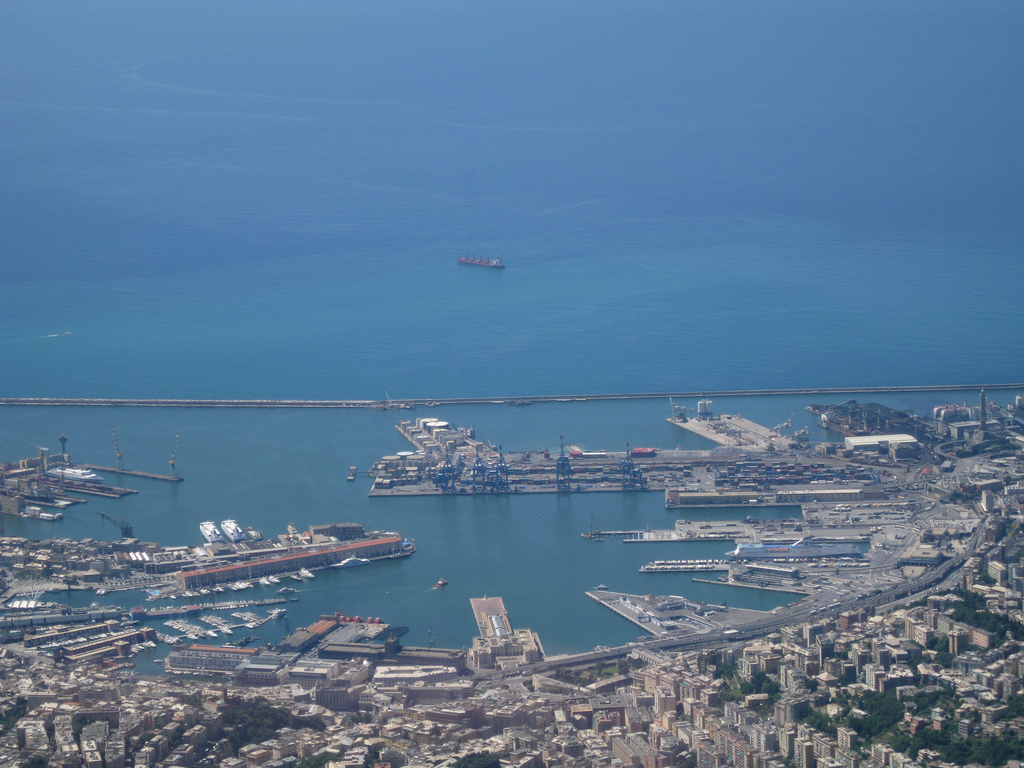
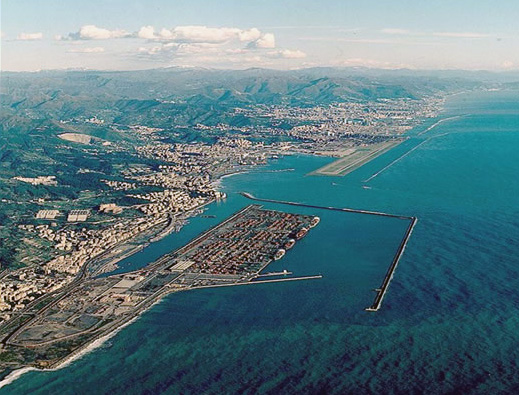
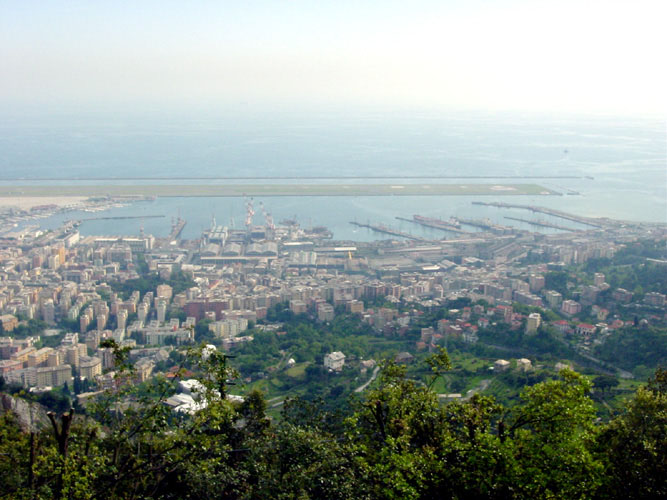
Vídeo:
Web recomendada: http://www.porto.genova.it/
Contador: 9413
Inserción: 2012-07-17 13:58:53
Lugares a visitar en un radio de 100 km (en línea recta)
Mapa de los lugares a 100 km (en línea recta)
Mostrando Registros desde el 1 hasta el 0 de un total de 0
Visitas |
Más visitados Basílica de San Marcos 154685 Catedral de Notre Dame (París) 144019 Torre de Pisa 131388 Monte Saint-Michel 100514 Presa de las Tres Gargantas 81306 |
Incorporaciones |
Comentarios hazola Cúpula de la Roca gracias me... gera Buenos Aires las mejores fotos de la mejor ciudad del... Daniel M. - BRASIL San Francisco ... PEQUE Presa Chicoasén SERA QUE ALGUIEN ME PUEDE DAR MAS INFORMACIÓN DE ESTE PROYECTO ESTUDIO EN LA UNACH Y ES PARA UN... Mery Huaca Pucllana Muy interesante, muy buena la información y... |
 Tweet
Tweet


